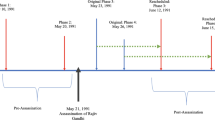Conclusion
Overall, the results show that the method of regulator selection does not seem to have a consistent statistically significant effect on electricity rates; consequently, the primary hypothesis of this research is not validated. Although the direction in the movement of relative rates through time is consistent with our expectations, we expected the magnitude of shifts in the importance of method of regulator selection, to be much more important than the research results indicate. This expectation was based on the external pressures which have emerged since 1970 to which elected regulators would seem to be more sensitive than appointed regulators. The empirical analysis indicates that the response to these external pressures was insufficient to cause elected regulators to set electricity rates statistically lower than those set by appointed regulators.
One can put forth several reasons for the lack of a statistical association between selection method and electricity rates. One, direct election of regulators may have the same apparent effect as the substitution of public for private ownership of public utilities. That is, public participation in regulatory matters can actually decrease since consumers may assume incorrectly that elected regulators will automatically act in their interests. Two, regulators may not have the flexibility necessary in setting rates to behave as our primary hypothesis dictates. The discretion of public utility commissioners is not only circumscribed by factors outside their control (e.g., input prices), but is also limited by legislated administrative procedures, judicial review, and federal legislation. Three, the effectiveness of state regulators is partly a function of staff competence and resources. An understaffed and inadequately funded commission can have difficulty in monitoring public utility performance and in evaluating requests for rate increases.
The empirical results indicate that consumer and other public interest groups, who desire to substitute elected commissioners for appointed commissioners as a solution to ineffective rate regulation, are in error. The absence of a statistical difference in price outcomes between the two forms of regulator selection implies that the substitution would generate unattainable expectations.
Similar content being viewed by others
References
Hagerman, R.L. and Ratchford, B.T. (1978). Some determinants of allowed rates of return on equity to electric utilities. Bell Journal of Economics 9 (Spring): 46–55.
Joskow, P.L. (1974). Inflation and environmental concern: Structural change in the process of public utility price regulation. Journal of Law and Economics 17 (October): 291–327.
Primeaux, W.J., and Mann, P.C. (1984). A seemingly unrelated regression analysis of regulator selection and electricity prices. Faculty Working Paper No. 1017, College of Commerce and Business Administration, University of Illinois, Urbana-Champaign, February.
Trebing, H.M. (1977). Broadening the objectives of public utility regulation. Land Economics 53 (February): 106–122.
Author information
Authors and Affiliations
Rights and permissions
About this article
Cite this article
Primeaux, W.J., Mann, P.C. Voter power and electricity prices. Public Choice 47, 519–525 (1985). https://doi.org/10.1007/BF00182152
Issue Date:
DOI: https://doi.org/10.1007/BF00182152



